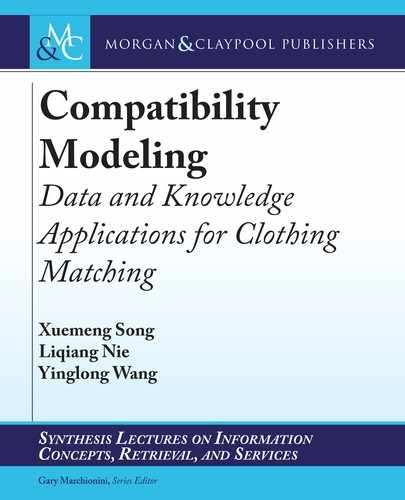7.5. EXPERIMENTS 89
based on the bag-of-word scheme, we represented the textural modality of each item as a 529-D
vector.
Parameter Setting. To control the total number of items in the wardrobe, the maximum and
minimum numbers of items in each category (i.e., N
max
and N
min
) are set to 5 and 3, respec-
tively. We adopted the grid search strategy to determine the optimal value for the regularization
parameter (i.e., ˛) in the range of Œ0; 1 with a step of 0.1. e numbers of hidden units for the
user preference modeling, user body shape modeling and garment modeling are set as 224 (i.e.,
K D 64 and D D 160 in Eq. (7.2)), 512 (i.e., 256 for both visual and textual representation), and
512, respectively. As aforementioned, the garment modeling is trained on the dataset in [31],
while the user modeling is learned by our bodyFashion. We then randomly sampled 180 users
from bodyFashion as the testing set, on which the model performance is reported.
7.5.2 ON MODEL COMPARISON (RQ1)
To evaluate the proposed PCW creation scheme, we chose the following baselines.
• POP. We added/deleted items according to its “popularity,” which is defined as the number
of users that have purchased the item.
• RAND. We randomly added/deleted items to create PCWs.
• Item Similarity Based Method (ISBM). We added/deleted an item according to its average
visual similarity to each item in the user original wardrobe, measured by the inner product of
their visual features extracted by ConvNet.
• Capsule Wardrobe Creation (CWC). Focusing on the outfit compatibility and versatility,
this method [41] creates the capsule wardrobes using a topic model over the item attributes.
Here, we directly adopted the descriptive words as the item attributes.
• Dynamic Collaborative Filtering (DCF-A). is user preference modeling approach [132]
incorporates the aesthetic features to boost the performance for item recommendation. We
adapted it as one baseline by dropping the time factor that is unavailable in our context and
adopting the state-of-the-art aesthetic features [112].
• ExDCF-A. We extended DCF-A by introducing our garment modeling score to its final
recommendation score of each garment for a user, where the linear fusion with equal weights
is adopted.
As it is intractable to obtain the exact ground-truth, we introduced the following three
metrics to softly evaluate the PCW creation: successful rate (SR), average improvement (AI),
..................Content has been hidden....................
You can't read the all page of ebook, please click here login for view all page.
